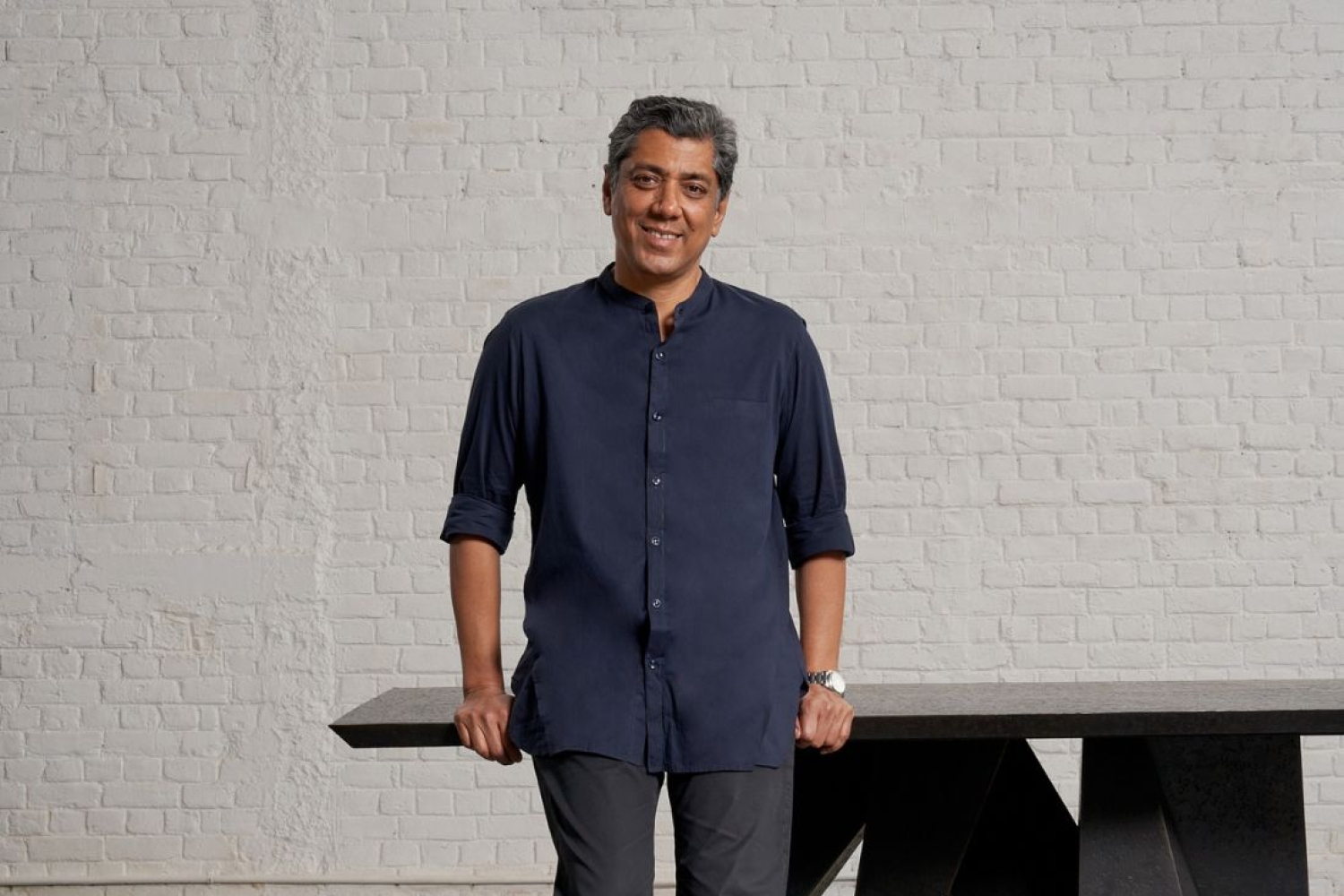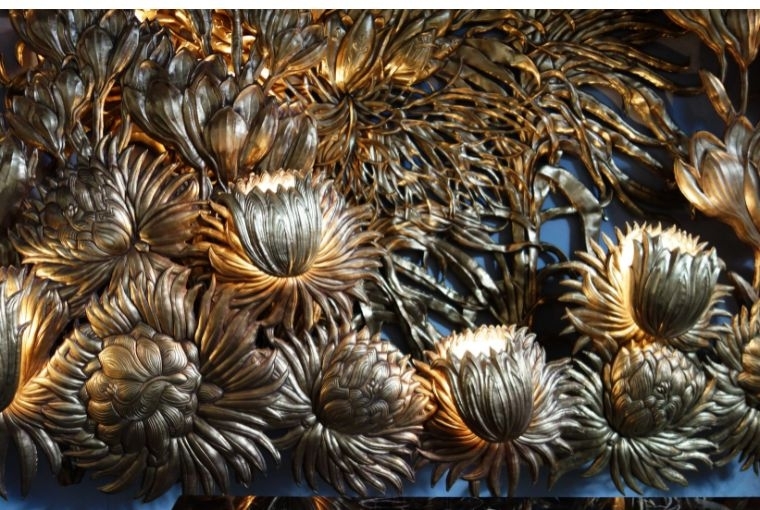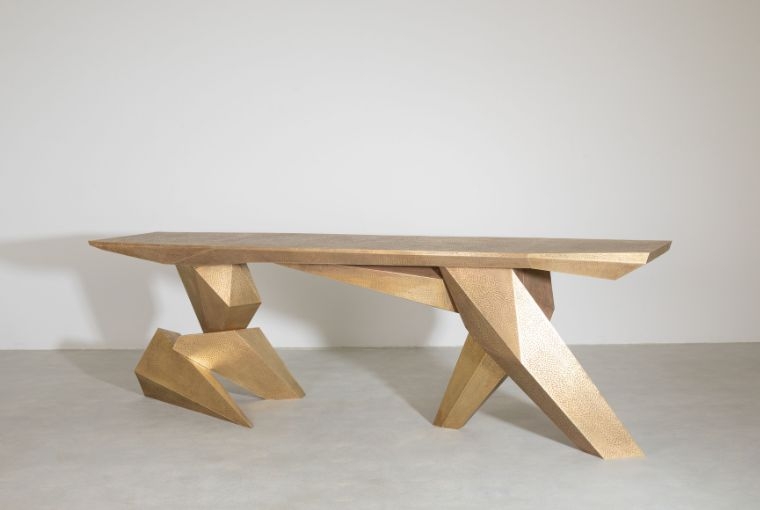

As you step inside Vikram Goyal’s New-Delhi based workshop, his mastery of metal will struck you. Over the years, he has refined his contemporary design language. The lesser known fact about Vikram is that he is also a specialist in the RepousseÌ technique, which involves hammering low-relief designs into malleable metal sheets.
As he walks us through his work at the studio, he tells us how months are spent experimenting and sampling the detailed, time-consuming technique, using the traditional repousseÌ process to create an unconventional design language. Born with the same approach is his new immersive work, Silken Passage—a 28 ft long and 8 ft high mural inspired by the Silk Road, which was yet to be mantled together for the ongoing Art Fair. Once he sits with some back coffee on the table to sip on, he explains how this route has enriched diverse cultures over the years and now his work; excerpts from the conversation.
What was the starting point for your new work?
I wanted to do something in our studio signature work, our repousseÌ work—the work which we do in all these big panels. In fact, they made a documentary on it. And mostly, our panels have been flat. So I wanted to move outside. I wanted to make it layered and three-dimensional.
Also, I wanted to expand our focus outside of the Indian things we’ve been working on. We’ve been working on various deities, various trees of life, et cetera. So, this was our idea to expand to a broader spectrum. The idea of the Silk Route has always fascinated me. I’ve brought a lot of Chinese and Japanese influence into my work, with the cranes and the oriental clouds. So I said let’s look westward as well. And the silk route was just the perfect way because all these countries have such a rich history of art and craft. And Indian cultural arts have been influenced by what came from Persia or Italy. This was a good way to start talking about integration as told through the Silk Route, which is a network of arrangements.

Part image of Silken Passage
What was the kind of research that went into this?
I decided to do it through flora and fauna. There are trees and vessels because vessels are such a metaphor for carrying things. I looked at the spectrum of six countries: Italy, Iran, Turkey, India, China, and Japan. Much research goes into how we choose to depict the different vessels of foreign countries. Some of them are abstract, so much thinking goes behind each product.
It takes months of preparation to think about what we want to do. How do we want to do it? What are some of the decorative elements we want to put into it? What are the materials we want to use? It’s a team effort. And then building this together, took several craftsmen. Some people did the cast elements, and some did the semi-precious elements. We needed raw elements which needed to be polished.
How you approach metal as a medium is very different from the traditional approach. Can you talk a little about it?
I’m not a trained designer or an art designer; I see myself in this third space where we are making an intervention in design and craft. Through the idea of our workshop, we are able to take risks. If we were to work with a different factory, there’s only so much time they give us to sample. Because of our Karkhana we can, in terms of technique and scale, work with very large objects. And within the umbrella of that workshop, we are able to experiment with artisans. But they’re used to working in a certain language. So we developed new tools for them. And they adapt very quickly. That’s the primary reason we’ve been able to stretch the boundaries of typical metal works.
You have mentioned that stories are a vital source of inspiration for your work. How do you incorporate narrative elements into your creative process?
Even though my aesthetic is very contemporary, I view myself as someone who is very rooted in legacy. The material we work with is brass, which is a traditional material in India. Back in the day, it was used in vessels, for surface decoration. It was the poor man’s gold. And the qualities that brass gives you make it easier for you to work with it. What you can do with brass, you can’t do in silver, copper, or bronze. You can get cast, you can work it on a sheet; it’s malleable. Its properties make it very versatile.
I grew up in Delhi and spent a lot of time travelling; I was always fascinated and deeply interested in the visual arts, architecture, and old paintings. My aesthetic is never fully super modern. Whatever I do, there are layers and texture to it. It has character. And that is because I’ve got this strong affinity towards legacy.

What do you think of the art coming out from India right now?
In the last decade, internationally, a lot of focus has moved to auction houses, art galleries, and collectors on what they call collectible design or limited edition design pieces. And that’s also being mirrored in India. In India, people have access to interesting raw materials to work with. And so you’re seeing some great work, which wasn’t the case before. It’s all very nascent. You have designers experimenting... some with block printing, some with weaving. So people are using traditional crafts in a different way. So I think this is just the beginning of what we are seeing. Also with Instagram, you have a platform to showcase your work at a very low cost. Technology has greatly helped to bring this kind of change.
Words Hansika Lohani
Date 01.02.2024